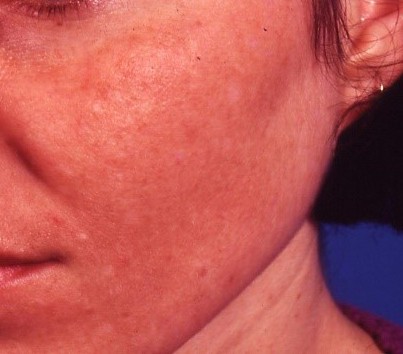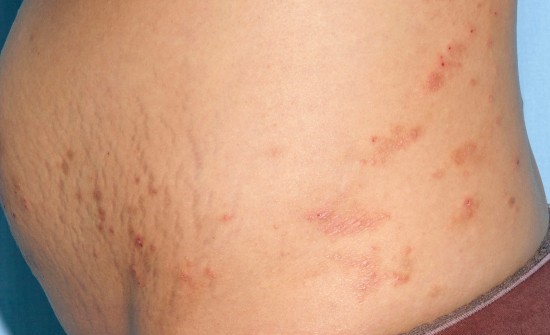Pregnancy Rash
During pregnancy, there are changes in the skin. These changes can be classified into 3 main groups
- Physiological skin changes (due to changes in hormones during pregnancy)
- Pre-existing skin conditions that change during pregnancy
- Pregnancy specific skin rash
1. Physiological skin changes in pregnancy which includes
- Stretch marks
- Pigmentation
- Hair and nail changes
- Vascular changes
- Skin growths
Stretch marks in pregnancy (Striae Gravidarum)
- Seen in up to 90% of pregnant women
- Extremely common in the second or third trimester
- Appear as pink or purple lines or bands which later become white
- Seen on the abdomen, buttocks, breasts, thighs or arms
- More commonly seen in
- Younger women
- Women with larger babies
- Women with higher body mass
- Women with history of breast or thigh striae
- Family history of striae gravidarum

Causes of Stretch marks in pregnancy (Striae Gravidarum)
- Causes are multifactorial and include stretching, weight gain and hormonal factors
Treatment of stretch marks in pregnancy (Striae Gravidarum)
- Prescription creams
- Lasers to improve the appearance
- Pulse dye laser: reduces red stretch marks and releases growth factors to smooth out the breaks in the skin
- Ablative and non-ablative Laser resurfacing
- Jet volumetric remodelling
- Thermo-mechanical remodelling
- Fractional radiofrequency
- Dermal filler injection
- Ultherapy
- Skin Infusion
Pigmentation in Pregnancy
There is a generalized increase in skin pigmentation during pregnancy. This is more obvious in darker skin women. Increased pigmentation is seen in the nipples, areolae, genital areas and midline of the abdominal wall (linea nigra). This pigmentation usually fades after delivery
Melasma in Pregnancy (Mask of Pregnancy)
Melasma can occur for the first time during pregnancy or pre-existing melasma may worsen during pregnancy. After delivery melasma may lighten but it often persists after pregnancy
Treatment of melasma in pregnancy
- Broad-spectrum sunscreen plus blue light filters
- Sun avoidance such as wearing hats, shades and UV clothing
- Prescription creams
- Chemical peels
- Laser treatments- usually perform postpartum

Hair and nail changes in pregnancy
- During pregnancy there is some degree of increased hair growth on the face, limbs and back. This resolves postpartum
- There is mild thickening of scalp hair due to prolonged anagen phase of hair growth in pregnancy. Postpartum there is increased shedding (telogen effluvium)
- Nails grow faster during pregnancy. There may be increase brittleness, transverse grooves, onycholysis and subungual keratosis. The nail changes resolve postpartum.
Vascular changes during pregnancy
Vascular changes occur in the third trimester and usually improve or cleared after delivery. They include
- Edema
- Varicose veins in the legs and hemorrhoids
- Spider angiomas and spider veins are common
- Redness of the palm
Treatment of vascular changes
- Sclerotherapy
- Laser treatment: Pulse dye V beam laser, Excel V Nd-YAG laser, ADVATx laser

Skin growths during pregnancy
Most of these are benign growths and include vascular and non-vascular growths
- Skin tags
- Moles may increase in numbers or size
- Pyogenic granuloma
- Angioma
Treatment of skin growths postpartum
- Surgery
- Laser removal
- Cryosurgery
- Electrodesiccation
- Incision

2. Pre-existing skin conditions that change during pregnancy
Acne during pregnancy
- Acne may worsen during the third trimester as maternal androgens increased
- Treatment is the same as in non-pregnant women except that oral medication is not allowed
- Chemical peels and LED light treatments are safe in pregnancy
Eczema during pregnancy
- Often eczema may worsen during pregnancy
- Treatment includes topical steroids and moisturisers
Safety of topical steroid in pregnancy
- Maternal use of topical steroid is safe. There is no association of any potency of steroid with mode of delivery, birth defects, preterm delivery, fetal death and low Apgar score (JAMA Derm Clinical Evidence Synopsis Cc Chi, et al)
- Very potent topical steroids in large accumulative dose is associated with low birth weight
3. Pregnancy specific skin rash (Pregnancy Dermatosis)
There are 4 pregnancy-specific skin rash and they are
- Atopic Eruption of Pregnancy (AEP): most frequent
- Polymorphic Eruption of Pregnancy (PEP)
- Pemphigoid gestationis (PG)
- Intrahepatic Cholestasis of Pregnancy (ICP): most important
1. Atopic Eruption of Pregnancy (AEP)
Previously known as
- Prurigo of pregnancy
- Pruritic folliculitis of pregnancy
The most common skin rash in pregnancy (50%)
- Occurs early, 75% before the third trimester
- Often seen in primipara (44%)
- Common in single pregnancies (99%)
- Patients may have atopic background, in which there is a tendency to recur in subsequent pregnancies
- In 20% there is an exacerbation of pre-existing atopic eczema
- 80% may experience atopic skin changes for the first time ever or after a long remission (for example since childhood)
- Up to 70% of patients have elevated serum Ig E levels
Clinical features of Atopic Eruption of Pregnancy (AEP)
- 2/3 will have widespread eczematous changes in the face, neck, flexure (E-Type AEP)

- 1/3 will have papules or prurigo on the trunk and limbs (P-type AEP)

Course and prognosis of Atopic Eruption of Pregnancy (AEP)
- Maternal: good prognosis, but recurrence in subsequent pregnancies is common
- Fetal: no risk. The infant may have a higher risk of developing atopic dermatitis
Treatment of Atopic Eruption of Pregnancy (AEP)
- Topical steroids
- Moisturisers
- Oral antihistamine
- Topical anti-itch medication. Menthol is safe
- Phototherapy
- A short course of systemic steroids in some
- Close monitoring for superimposed bacterial infections
2. Polymorphic Eruption of Pregnancy (PEP)
Also known as:
- Pruritic urticarial papules and plaques of pregnancy (PUPPP)
- Toxic erythema of pregnancy
- Late-onset prurigo of pregnancy
Cause of Polymorphic Eruption of Pregnancy (PEP)
- Cause often unknown
- It May be caused by increased abdominal distension or Maternal-fetal cells immune system
Clinical features of Polymorphic Eruption of Pregnancy (PEP)
- It is the 2nd commonest pregnancy-specific skin rash
- Occurs in 1:160 deliveries
- Seen predominantly in primigravidae
- Develops in the third trimester
- There are some risk factors such as
- Excessive maternal weight gain
- Multiple pregnancies
- A family history
- Characteristics of Polymorphic Eruption of Pregnancy (PEP)
- Red and intensely itchy rash
- Often begin in the stretch marks
- Not seen in the umbilicus
- The face is not affected
- Take various forms (polymorphic) such as hives, bumps, red papules or patches, blisters

Course and prognosis of Polymorphic Eruption of Pregnancy (PEP)
- Maternal: good, rash resolves 1-2 weeks after delivery
- Fetal: no risk
Treatment of Polymorphic Eruption of Pregnancy (PEP)
- No specific treatment
- Oral antihistamines
- Topical corticosteroids for the itch
- Oral corticosteroids for severe rash
3. Pemphigoid gestationis (PG)
- This is an autoimmune skin disorder
- Affects 1:20,000-50,000 pregnancies
- Onset in the 2nd and 3rd trimester but may arise at any stage during pregnancy
- The rash takes a variable course
- It generally improves in late pregnancy
- It resolves after pregnancy
- Or it may get worse in the immediate postpartum period
Clinical features of Pemphigoid Gestationis (PG)
- The rash is itchy
- The rash looks like grouped or annular rings of red papules, plaques or blisters
- The rash affects mainly the abdomen including the umbilicus but may be generalised
Course and prognosis of Pemphigoid Gestationis (PG)
Maternal
- It can recur with menstruation and with oral contraceptives
- It can recur in subsequent pregnancies
- In subsequent pregnancies, symptoms become more serious and develop earlier
Fetal
- 5 – 10 % of new-borns will develop a blistering rash due to the mother’s antibodies crossing the placenta. The rash is temporary, lasting 6 weeks
- Mild placental failure has been associated
- Associated with premature deliveries
- Newborns are small for gestational age


Treatment of Pemphigoid Gestationis (PG)
- Relieve itching with antihistamine
- Prevent blister formation with topical or oral steroids
- In severe patients, immunosuppression may be needed
- Secondary infection is treated
4. Intrahepatic Cholestasis of Pregnancy (ICP)
Also known as
- Pruritus Gravidarum
- Obstetic cholestasis
Affects 0.02-2.4 % of pregnancy
There is often a family history
Clinical features of Intrahepatic Cholestasis of Pregnancy (ICP)
- Unexplained itch during the second or third trimester
- Itch felt in the abdomen, the palms and soles or may be widespread
- There is no primary skin rash
- Excoriations to severe itch bumps may be seen
- Jaundice occurs in 10% of patients and is often mild
Course and prognosis of Intrahepatic Cholestasis of Pregnancy (ICP)
Maternal
- Itch
- Risk of bleeding complications due to Vitamin K deficiency
- 10% concomitant extrahepatic cholestasis
Fetal
- Risk correlates to bile acid levels > 40umol /L
- Prematurity and stillbirth (19-60%)
- Fetal distress (22-33%)
- Risk of bleeding complications due to Vitamin K deficiency
Treatment of Intrahepatic Cholestasis of Pregnancy (ICP)
- The mild itch may be treated with an oral antihistamine
- Ursodeoxycholic acid (UDCA) is the first line of treatment
- It is a naturally occurring non-toxic bile acid
- Can significantly reduce prematurity or stillbirths
- Close obstetric care with weekly CTG from week 34





